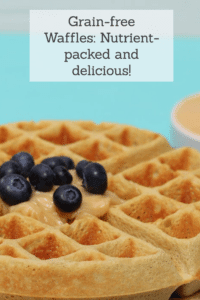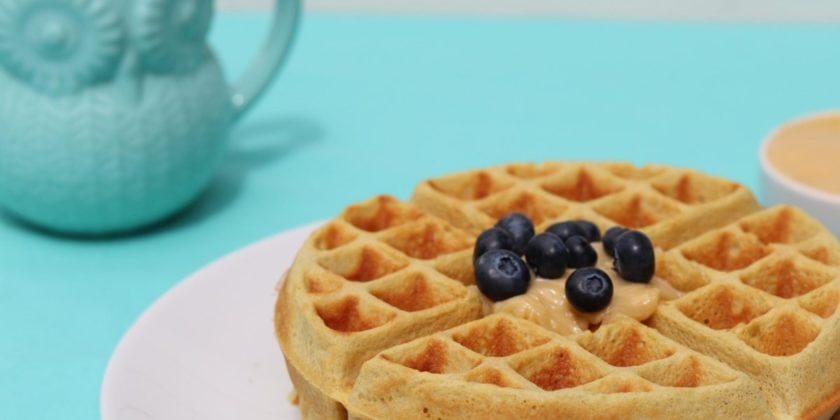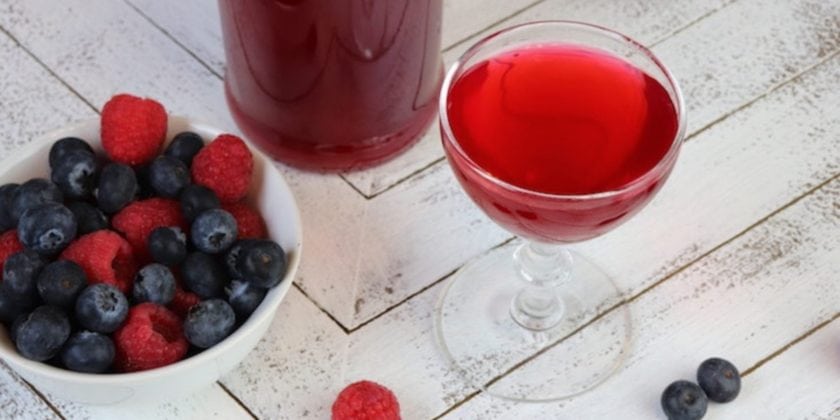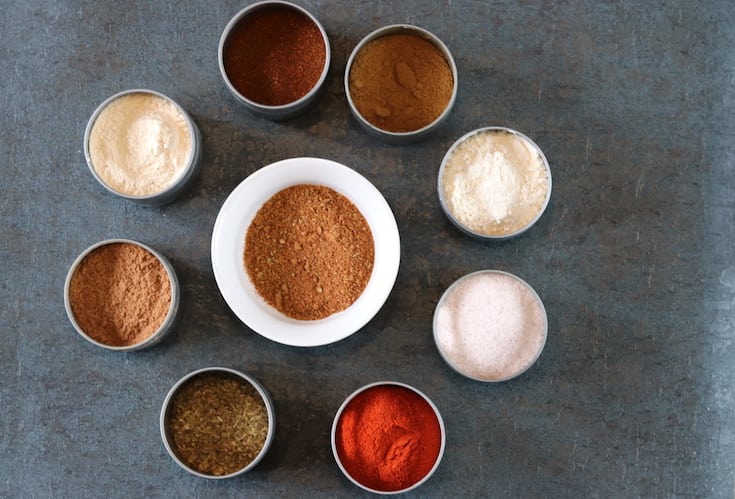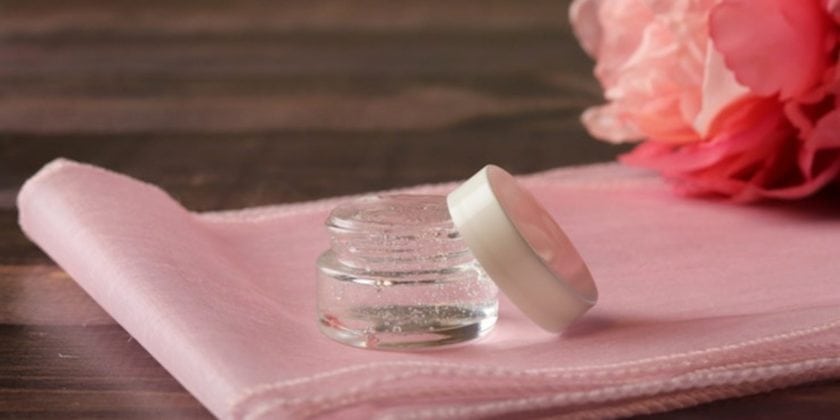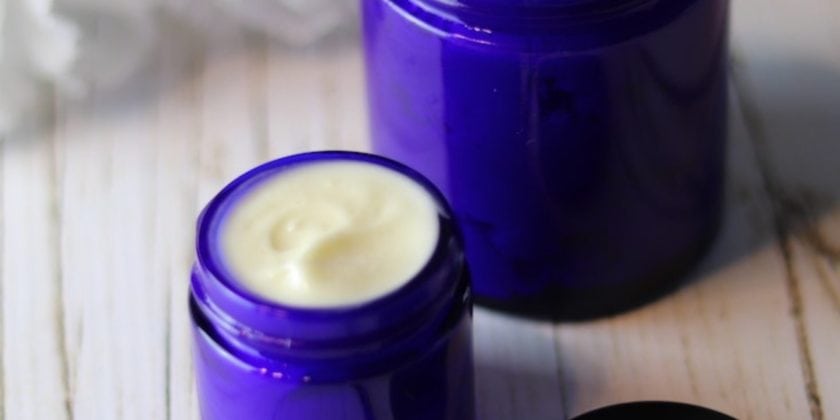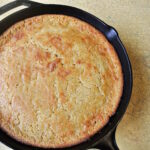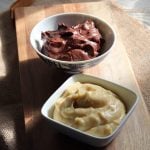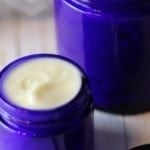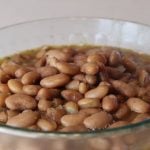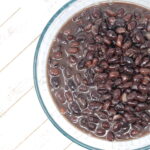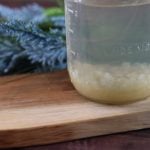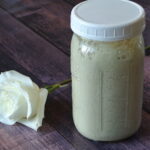You won’t even notice that these nutrient-packed, grain-free waffles are gluten-free and grain-free! The recipe is very simple to make which is why these were my go-to breakfast while I went three months without a kitchen (dishwasher flood forced an impromptu kitchen remodel!)
Depending on the season, I usually do these Sourdough Waffles (wheat) or these Buckwheat Sourdough Waffles (gluten-free), but not having a place to do dishes or any counters to cook on, I decided to store my starters in the refrigerator and then created this recipe. This recipe uses no gums (such as xanthan, guar, etc.) so it’s a good choice for those with digestive issues. It uses three types of flour, which may seem weird if you are used to making wheat-based recipes. However, if you are no stranger to gluten-free or grain-free baking, you will know that it takes a combination of flours to recreate a wheat-like texture. If nuts or nut flours are an issue for you, simply replace the almond flour with more buckwheat flour. They will still be super fluffy and tasty! I have the almond flour in there mostly for nutritive reasons.
Although my kitchen is back together and better than ever, I still rotate these nourishing grain-free waffles in quite frequently. They are so easy and so tasty! Let me run through the nutritional information for you.
nutrition information For these nutrient-packet, grain-free waffles:
Buckwheat flour: Buckwheat flour is one of my favorite grain-free flours. I use Acadian buckwheat which is lighter in flavor and texture than other buckwheat flours. Buckwheat is definitely the star (both in taste and nutrition) of the flours in these grain-free waffles!
- is high in magnesium! Magnesium helps with calcium absorption, which helps with bone health, heart health, a good night sleep, as well as many other things. Unfortunately, between soil depletion and poor diets, most of us are deficient in magnesium. (Go here to see if you have a magnesium deficiency and to learn about the myriad of health issues this can cause. Go here to learn how to make your own magnesium roll-on to apply to your feet before bed.)
- is a good source of potassium, iron, and B vitamins.
- has more protein than any of the grains traditionally consumed in the SAD (Standard American Diet), such as wheat, rice, or corn.
- contains the essential amino acids lysine and arginine. Lysine benefits your gut, your brain, as well as coldsores or other herpetic lesions. Arginine supports the kidneys and bladder, as well as helps alleviate congestive heart failure.
- contains a fair amount of resistant starch (Source). Resistant starch (aka prebiotics) balance your microbiome. Getting prebiotics is as important, if not more important, as getting probiotics!
Cassava flour: Cassava flour adds a light and fluffy texture in these grain-free waffles. It is no slouch when it comes to nutrition though, as you can see below.
- low on the glycemic index
- contains B complex vitamins
- excellent source of vitamin C
- contains the important trace minerals calcium, magnesium, iron, potassium, zinc, and manganese
- high in resistant starch to balance your microbiome which reduces inflammation
Blanched almond flour: (check out this article from Dr. Axe for a more in-depth look at almond flour). I added almond flour to these grain-free waffles for texture as well as variety in the nutrition department.
- good source of vitamin E, manganese, magnesium, calcium, copper, and potassium
- source of good fats
- low glycemic score
Pastured eggs:
Pastured eggs come from chickens foraging outside eating nutrient-rich bugs and vegetation and soaking up vitamin D from the sun! Because of this, their yolks contain vitamin D, healthy omega 3 fats, most of the B vitamins as well as vitamins A and E. They also contain some hard to get nutrients like vitamin K, choline, and selenium. The egg whites contain protein, magnesium, potassium, and sodium. They are nature’s perfect food.
Why I avoid conventional eggs:
A conventional chicken egg comes from factory-farmed chickens who are kept in cages without sunlight (this is why their eggs have little to no vitamin D). They are fed conventionally grown grains and often soy, both of which are almost always GMO. Often the cages are stacked on top of one another and they poop all over each other. Close quarters means a lot of sickness, so they are given antibiotics to keep them “healthy”. Even “cage-free” chickens are only required to have a few feet per bird and they are often not able to forage. They may not even be in the sun, ever. Some cage-free farms have their birds inside on the floors of large barns. In my opinion, conventionally raised chicken eggs are little toxic bombs that do way more harm than good to your body, and I avoid them! You probably guessed that I also avoid eating conventionally raised chicken meat. 🙂
Non-homogenized, grass-fed milk (or milk substitute of your choice):
While I generally use raw milk, since this recipe cooks the milk, grass-fed non-homogenized milk is a good option. Of course, if you have issues with dairy, you will want to substitute with a non-dairy milk such as homemade hemp milk, coconut milk, almond milk, etc. See below if you are not sure why you should be buying non-homogenized, grass-fed milk (or raw milk).
Homogenization: When milk is homogenized, the fat particles are spun around very quickly until they become very small. They become something unrecognizable to your body. It is a similar problem to those of trans-fats, also known as hydrogenated fats. We have all heard by now about the dangers of hydrogenated fats, although they are still hidden in many processed and prepared foods. If you don’t have the choice to buy raw milk in your area, choose an organic grass-fed, non-homogenized version.
Grass-fed: When a cow eats the food it was meant to eat (grass), you get all the health benefits of the grass without having to eat the grass yourself. When cows eat grain or corn, especially non-organic grain or corn that is GMO and heavily sprayed, you get the drawbacks, of that diet. We could also mention that the quality of life of a grass-fed dairy cow is much preferable to that of a poor, conventional dairy cow. Go here for a great article from Dr. Axe on the benefits of raw dairy.
Grass-fed butter: this butter is higher in nutrients and CLA, conjugated
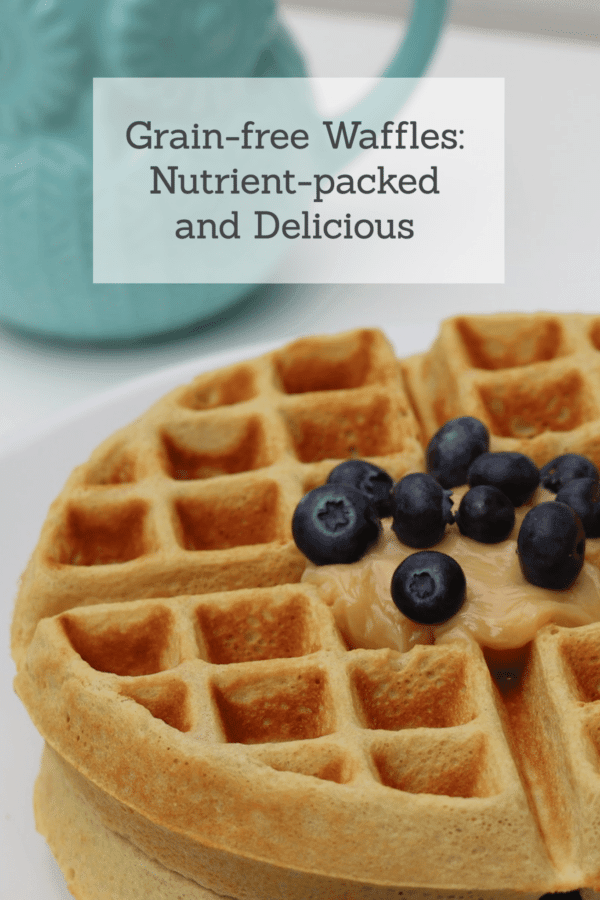
linoleic acid, (which is a fat burner, and muscle and immune system builder) than regular butter. Go here for an article from Dr. Axe on the benefits of grass-fed butter and ghee.
Sea salt: real sea salt is higher in minerals than iodized salt and has no clumping additives like iodized salt. Go here to learn about the health dangers of table salt and switch to sea salt ASAP!
How to make Delicious nutrient-packed, grain-free waffles:
- 1 1/4 cup of acadian buckwheat flour (this is a much lighter flour than most other buckwheats)
- 2 Tablespoons almond flour
- 2 Tablespoons cassava flour
- 3 pastured eggs, lightly beaten
- 1 to 1 1/4 cups whole non-homogenized milk (or milk alternative)
- 1 tablespoon baking powder (buy corn-free if you are concerned about a sensitivity)
- 3 tablespoons grass-fed butter, melted
- 1/2 teaspoon fine sea salt
Directions for grain-free waffles: If you are using a regular waffle maker, you will get about 5 waffles. If you are using a Belgian waffle maker, you will probably want to double the recipe. These waffles freeze well.
- Combine the dry ingredients in a large bowl.
- Next, add the eggs and milk (start with the smaller amount of milk and only add more if needed after the resting period.)
- Whisk until well blended. You don’t have to be gentle with this batter like you do a wheat based waffle or pancake batter.
- Let the batter rest for 8 minutes to properly hydrate the flours.
- After the resting period, add the melted butter and mix.
- Add the rest of the milk, if needed. The batter should have a “trace” left when the whisk or ladle is picked up.
- Follow the manufacturer’s instructions for your waffle maker. For my regular waffle maker, I use about 1/2 cup of batter and cook for 5 minutes. For my Belgian waffle maker, I use a one cup ladle over-full and cook for 4 minutes.
We love to top our waffles with freshly made grass-fed whipped cream and fresh berries if we have them on hand. Another favorite topping is maple butter. Try a cultured version for extra probiotics.
Note: If you are using a regular waffle maker, you will get about 5 waffles. If you are using a Belgian waffle maker, you will probably want to double the recipe. These waffles freeze well.
Delicious, Nutrient-packed, Grain-free Waffles with no gums
Ingredients
- 1 1/4 cup of acadian buckwheat flour this is a much lighter flour than most other buckwheats
- 2 Tablespoons almond flour
- 2 Tablespoons cassava flour
- 3 pastured eggs lightly beaten
- 1 to 1 1/4 cups whole non-homogenized milk or milk alternative
- 1 tablespoon baking powder buy corn-free if you are concerned about a sensitivity
- 3 tablespoons grass-fed butter melted
- 1/2 teaspoon fine sea salt
Instructions
- Combine the dry ingredients in a large bowl.
- Next, add the eggs and milk (start with the smaller amount of milk and only add more if needed after the resting period.)
- Whisk until well blended. You don't have to be gentle with this batter like you do a wheat based waffle or pancake batter.
- Let the batter rest for 8 minutes to properly hydrate the flours.
- After the resting period, add the melted butter and mix.
- Add the rest of the milk, if needed. The batter should have a "trace" left when the whisk or ladle is picked up.
- Follow the manufacturer's instructions for your waffle maker. For my regular waffle maker, I use a about 1/2 cup and cook for 5 minutes. For my Belgian waffle maker, I use an overflowing one cup ladle and cook for 4 minutes.
Notes
